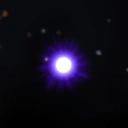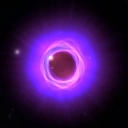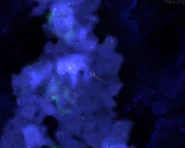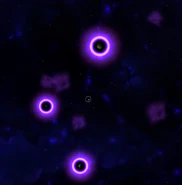
Game art of ships entering hyperspace
| This topologically exotic medium of not-quite space-time is used by starships to side-step the speed of light for interstellar travel. | ||
–Hyperspace | ||
Hyperspace is the only means of interstellar travel in the Sector.
To enter hyperspace a fleet must travel to and interact with a jump point, where it can then perform a jump into hyperspace. Fleets can exit hyperspace at jump points, or at the gravity wells around gas giants and stars.
The Transverse Jump ability is unlocked with the Navigation Skill and provides alternate means of entering hyperspace from any point within a system, at a small combat readiness and fuel cost, and can be used to enter a system though the use of nascent gravity wells formed by large planets in-system.
Traveling in hyperspace uses fuel. The rate of fuel usage and remaining stores of fuel can be found in the bottom left user interface element, which can be hovered over with the mouse for more details or hover & F1 to provide a detailed breakdown of fuel usage per ship. If a fleet runs out of fuel while in hyperspace it will drift towards the nearest gravity well and fall back into normal space there. If it is not an inhabited system then searching for Salvaging opportunities or using the Distress Call ability may provide enough fuel to get back to a market to purchase more fuel.
Sensor ghosts of various types may be encountered in hyperspace.
Jump points[]
There are two types of jump points, proper two way jump points and one-way gravity wells, which act as de facto jump points to enter a system. Sufficient gravity wells for jump transits are formed on stars and gas giants; these points can only be used from hyperspace to jump (or fall) into a system. Regular two-way jump points can be used to both enter & leave hyperspace. Systems usually have at least two jump points; an inner jump point that usually shares an orbit with the system's major planet, and a fringe jump Point which revolves around the Sun farther out than the farthest planet, although exceptions do exist.
There are also nascent gravity wells, which are formed by smaller-than-gas-giant bodies within the system. The player can use these to drop from hyperspace directly into the vicinity of a specific planet, but it requires the use of the transverse jump ability. The existence of nascent gravity wells means that hyperspace can be used to traverse long distances within a star system by transverse jumping into hyperspace, flying to the destination's nascent gravity well, and then transverse jumping into its vicinity.
Deep hyperspace[]
Hyperspace contains Deep Hyperspace zones, denoted by dark clouds. Fleets in deep hyperspace have half the sensor profile and are slowed by diminishing your speed the bigger your fleet is, similarly to nebulae in normal space. They can make excellent ambush nests, provided care is taken to move when a storm starts forming.
| This volume of hyperspace is particularly chaotic, hindering performance of even hyperspace-calibrated equipment. | ||
–Deep Hyperspace | ||
Hyperspace Storms[]
Deep hyperspace clouds can randomly independently turn into hyperspace storms. Deep hyperspace clouds will glow brighter for a few seconds before turning into a storm. Storms are brightly lit with flashes of lightning.
Hyperspace storms cause periodic randomly storm strikes to fleets inside them. Strikes deal great damage to a randomly selected ship's hull, armor and combat readiness (but cannot kill ships outright) and also toss the fleet a considerable distance through space. Larger fleets incur more damage upon a strike.
| This volume of hyperspace is undergoing chaotic phase shifts leading to wildly fluctuating resonance cascades. Ancient and dire warnings of prolonged exposure to so-called "hyperspace storms" have been passed down through generations of spacers. | ||
–Hyperspace Storm | ||
Hyperspace Storm Surfing[]
Plowing through a storm area can cost significant supplies; however a savvy (or foolhardy) captain may also deliberately fly into hyperspace storms in an attempt to get more speed.
Storms potentially increase a fleet's maximum burn speed higher than the nominal 20 burn speed maximum, potentially up to the 30 burn speed hard cap. No additional fuel is consumed for increasing burn speed above 20. This makes trips much faster and more fuel efficient if you can stay on course. The nuanced skill to this is in the way that individual storms will divert the fleet off course; the further the fleet is from the relative centerline of the storm the more it will divert the fleet, while passing through the direct center of the storm will not divert the fleet at all. Hyperspace storm surfing is an exercise in adjusting the trajectory to go all in down the center of the storm.
Emergency Burn can be quite useful for ensuring a particular trajectory before or after hitting a storm, due to its high acceleration. Conversely, Sustained Burn is detrimental to control and should be disengaged when entering a hyperspace storm. Remember that storm strikes are more damaging for larger fleets and a large fleet might not be able to use Emergency Burn directly after a strike due to at least one ship having insufficient CR.
The costs of hyperspace storm surfing can be highly mitigated with the Solar Shielding hullmod.
Slipstreams[]
Slipstreams are described in-game as "currents, not unlike those navigated by Old Earth sailors." They are large tunnels which connect distant, arbitrary points in hyperspace. When a player enters a slipstream, they will be forcefully pushed along towards the slipstream's exit; the player must steer using their fleet's engines to stay inside the slipstream, lest they get ejected at each turn and corner. The slipstream can be exited whenever the player may please.
Abyssal hyperspace[]
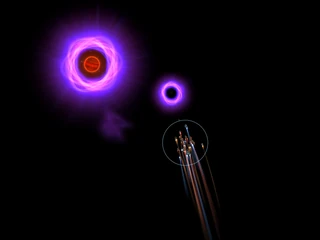
The Limbo star system in the abyss
Abyssal hyperspace is found in the bottom-left of the map (the region marked "Orion-Perseus Abyss") and around the edges of the rest of the map. Within this area, the interstellar background and other visual details are shrouded in darkness. Sensor range and burn speed are reduced to 0.25× their normal value, and gravity wells and jump points are only visible at close range.
Media[]
Change History[]
0.9
- Toned down the effect of hyperstorm strikes on fleet movement
- Adjusted storm strike target selection and CR damage so that Emergency Burn remains usable for large fleets after multiple strikes
- Added help popup explaining interaction with Emergency Burn when fleet is first hit by strike
- Slightly increased the amount of clear "lanes" in hyperspace

Only up to date for version 0.95.1. It is likely still broadly correct but not verified for the most up to date data yet. Please double check the Version History.

